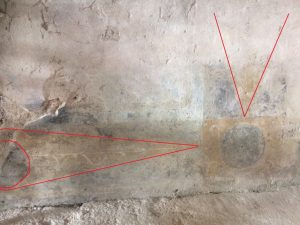One day staring at roughly made medieval walls looking for fragments of frescos; the next scrambling through thick undergrowth up to a hilltop ruin; another day unearthing pot sherds from hard clay; the next driving across Campania to see the major medieval churches, slipping in between various ongoing weddings; and each night returning to the great airy hall of the convent where we were staying (not home to nuns, but to a friar). Such was my exciting and varied experience of being an Undergraduate Research Scholar on the ‘At the Crossroads of Empires’ project. It was a privilege to be part of and an invaluable learning opportunity which has helped me to grow both academically and personally.
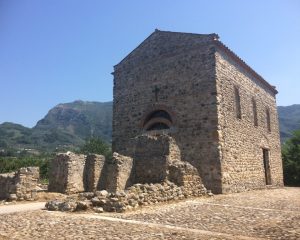
The main object of the study was the Longobard Church of Sant’Ambrogio at Montecorvino Rovella, Italy (Pic. 1). Built in the 9th century it is particularly interesting, not just for its age and completeness (only the roof and façade have been reconstructed), but for the fresco within its apse (Pic. 2). The fresco’s age is just the beginning of its distinctiveness, the depiction of Saints Ambrose (near left), Simplican (near right), Gervasius and Protasius (far left and right), all Milanese in origin, is unique for this region at this time. Its presence here, at the heart of the Lombard Duchy of Beneventum (later the Principality of Salerno), which was a major buffer/border state between the Byzantine and Carolingian empires, is incredibly intriguing. Its purpose is also something of a mystery, though most likely it was a mortuary, burial, chapel (making for some potentially exciting archaeology). Our aim was to contextualise the church and its fresco through archaeological excavation at the site and art historical reconstruction of the church’s frescos, as well as by exploration of other local churches’ art and the surrounding geopolitical environment.
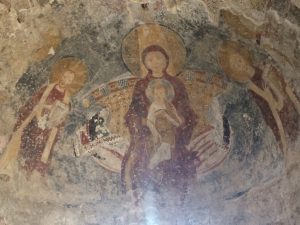
One of the most interesting experiences I had occurred on a trip to Salerno, exploring the Royal Chapel with UEA Art Historians, Professor John Mitchell and Dr Beatrice Leal, and my fellow Birmingham Undergraduate Kylie. Arechis, the Lombard Duke of Benevento, built the chapel as part of his palace in Salerno, his capital city. Later Sant’Ambrogio lay within the territory controlled from this palace, so it had much relevance to our study. It was wonderful to see Professor Mitchell and Dr Leal making sense of the seemingly random and chaotic walls, and we learned much from watching them. Indeed, by the end we were able to help them in some small way, spotting fragments to unscramble the mystery of the walls!
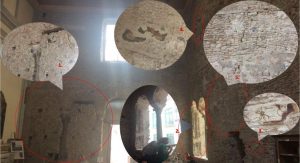
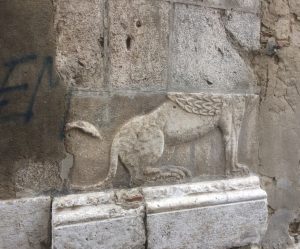
1: Along the front of the building are the remnants of arches from the original palace. Built using parts of Roman buildings (Pic. 4) they lined a front balcony by which the Duke would have accessed the chapel from the palace (it is now accessed by stairs straight up). 2: Around the windows are strong bands of colour, red, yellow, light and dark blue, the same as many of the other frescos in the building. 3: There are also many distractions. A very bold patch catches one’s attention, however, this is a 13-14th century tomb painting. 4: High up in the wings a small arch is faintly visible, painted in the same colours as the window, with the red and yellow painted to give it the illusion of being three dimensional. 5: The most interesting part of the wall were these several large pieces of painted fresco at the top and the bottom. We spent most of the time looking at these, venturing the interpretation that several pillars, with arches at their top, ran the length of the wall, coloured borders at their top and bottom. We had too little definite information, looking from the floor, to make any certain interpretations. But it was wonderful to see how art historians approach such problems. An area of particular interest was the diamond at the bottom left of the wall, similar to those in the borders on the walls of Sant’Ambrogio.
It is incredible to imagine how the highly painted interiors of these early medieval churches might have looked – so splendid! But sometimes we didn’t have to imagine. One of my highlights from the trip was visiting the amazing decorated church of San Angelo in Formis, with its astonishing, nearly complete, 11th century frescos. The walls depict the entire life of Jesus, while on each pillar old testament prophets hold their prophecies, pointing to the parts of his life that theirs refers to.

The whole project was a wonderful experience, and I learned so much from the time I was able to spend with so many experienced academics. I am very thankful to Dr Daniel Reynolds and Dr Francesca Dell’Acqua, as well as the many other students and scholars on the project, from the Universities of Birmingham, Salerno and UEA, all of whom taught me so much over the course of the project!

Benjamin Sharkey, BA History


